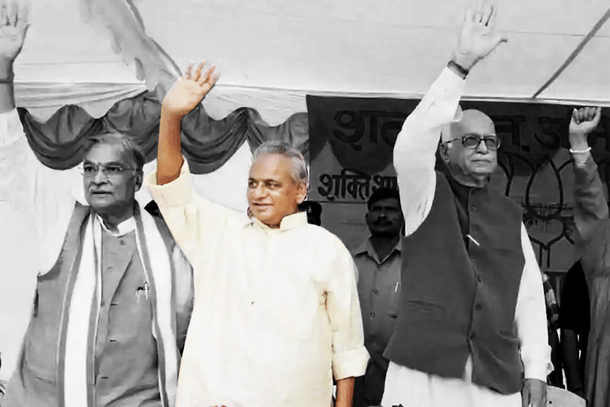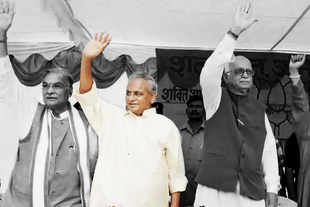Politics
What Kalyan Singh Meant To The BJP And Indian Politics
Vikas Saraswat
Aug 22, 2021, 10:15 AM | Updated 10:15 AM IST
Save & read from anywhere!
Bookmark stories for easy access on any device or the Swarajya app.


Very few politicians have created as much buzz with as little time in power as Kalyan Singh. As someone who not only dominated BJP’s politics in the state for two decades but also became the face of rebellion against secular hypocrisy, it might come as a surprise to many that the BJP stalwart was chief minister of Uttar Pradesh for just about three-and-a-half years. His two tenures as chief minister of the state in 1990s were one of the most eventful in Indian politics as well as in Bharatiya Janata Party’s inner party machinations.
Born on 5 January 1932 in the Madhauli village of Aligarh district, Kalyan Singh’s fascination with Rashtriya Swayamsevak Sangh began as a student. A school teacher and a kabaddi enthusiast, Kalyan Singh completed his college education from Dharma Samaj College, Aligarh. He contested his first assembly election on Bharatiya Jan Sangh ticket in 1962 from Atrauli. A 30-year-old Kalyan might have lost his first election but there was no looking back.
From 1967 to 2004 he continued to represent Atrauli with just one term break in 1980. A prominent face of the opposition by 1975, he had to suffer a 21-month jail term during the Emergency.
Kalyan Singh, also called Babuji by his admirers, was the first chief minister of the saffron party in UP. His first stint as CM breathed a new life in the state’s rotting administration and bureaucracy. A number of administrative and revenue reforms were brought in in the short one year tenure. Registrations of deeds which could be indefinitely held up by the Revenue Department were ordered to be expedited within two working days. Indiscriminate seizures and surveys by the Sales Tax Department were made conditional to approval by the District Magistrate. Irrigation canals throughout the state were cleaned for the first time in decades. A system of “Prabhari Mantri”, a minister responsible for all governance related issues in every district in the state, was introduced.
However it was the educational reforms, particularly the stringent Anti-copying Act, which are remembered most from this tenure. UP, which was notorious for copying in exams, saw the pass percentage in High School drop to 13 percent.
But more than ”good governance” which became both a professed model of the government and much cited public term in media and public discourse, it was demolition of the Babri Mosque by karsevaks and Kalyan Singh’s reaction to the event which gave him a place in history. Kalyan Singh not only refused to order any firing on karsevaks, he told the Director General of Police who had come to seek his permission that “I am ready to give you in writing that you had come to seek permission for firing but it is me who refused the permission”. He repeated the message in similarly firm terms to the then Home Minister Shankar Rao Chavhan also.
Tendering his resignation after demolition of the structure which signified collective humiliation of Hindus, Singh said he was ready to forsake power again and again for the sake of Ram Lalla. In his submissions before the Liberhan Commission and also the Courts, he said that none of his officers should be prosecuted for Babri demolition for which he and he alone was responsible.
Kalyan Singh was later sentenced to a day’s imprisonment for failing to protect the controversial structure. He wore this imprisonment as a badge of honour all his life.
Kalyan Singh’s second term was again a volatile one. He had to suffer a gubernatorial coup executed by Romesh Bhandari which lasted only for a day but was enough to affect the second phase of ongoing Lok Sabha elections which saw rampant booth capturing by Samajwadi Party in several constituencies. As a result, repoll had to be ordered on several booths in 29 Parliamentary constituencies. Kalyan Singh’s second stint in power was notable for ordering Bharat Mata prayers and Vande Mataram greetings in the schools.
It is in this tenure that he rebelled against central leadership and was sacked from the party. The decision cost BJP heavily and set in a steady decline in the party's fortunes which could be reversed only after the charismatic Narendra Modi arrived on the national scene.
Although Kalyan Singh had rejoined BJP in 2004, party organization and enthusiasm had weakened considerably by then. In 2009, Kalyan Singh once again left the party, this time on his own. His alliance with Samajwadi Party helped neither SP nor his own Jan Kranti Party. He returned back to BJP before the 2014 Lok Sabha elections.
The political significance of Kalyan Singh lies in the fact that he not only added a crucial chunk of OBC vote to BJP but endeared them permanently to the hitherto upper-caste saffron party. That he managed to do so in the aftermath of Mandal politics makes him an even more important figure. The nationwide rise of the BJP, driven in great measure by the rise of Hindutva fervour amongst OBCs, can find its attribution in the rise of Kalyan Singh to a large extent.
In that sense, the BJP’s meteoric rise under Narendra Modi, also an OBC, can be traced back to Kalyan Singh. PM Modi has acknowledged the importance of Kalyan Singh by referring to his “good governance” model in several public meetings.
By being a key figure in the rise of both Hindutva and “good governance” politics, Kalyan Singh has had a truly prodigious career. Also without his unambiguity and readiness to sacrifice for the Ram Mandir cause, the temple in Ayodhya might still have been a distant dream. For that, the Hindu society will always remain indebted to this Ram bhakta.





